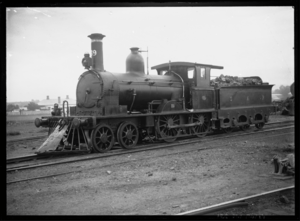South Australian Railways L class
The South Australian Railways L Class Locomotives were built by Beyer, Peacock and Company for the South Australian Railways and were introduced to the system in 1880.[1]
| South Australian Railways L Class | |||||||||||||||||||||||||||||||||||||||
|---|---|---|---|---|---|---|---|---|---|---|---|---|---|---|---|---|---|---|---|---|---|---|---|---|---|---|---|---|---|---|---|---|---|---|---|---|---|---|---|
 South Australian Railways L Class No. 39 | |||||||||||||||||||||||||||||||||||||||
| |||||||||||||||||||||||||||||||||||||||
| |||||||||||||||||||||||||||||||||||||||
| |||||||||||||||||||||||||||||||||||||||
| |||||||||||||||||||||||||||||||||||||||
History
The four L class tank locomotives that were purchased from Beyer, Peacock and Company for the South Australian Railways in 1880 were meant to work on the Port line. There was a problem straight away with the new locomotives, they were found to have an axle load which was too high for the track and bridges that they would run over. To solve this problem the S.A.R. went and purchased four six wheeled tenders from Dübs and Company, Scotland and removed the side water tanks to bring the axle load down to a more acceptable level. With the L class entering service as tender locomotives they were put to work on the northern lines, as far as Riverton and heading further north once heavier track was laid up to Terowie. The L class also worked Kapunda and on the Adelaide to Nairne section of the "Intercolonial Railway". Later in life the L class worked in the eastern area of Murray Bridge, which included mixed trains to Pinnaroo. When S.A.R. commissioner William Alfred Webb's famous "Big Power" locomotives arrived in 1926, this put the now smaller L class locomotives to limited work. This eventually resulted in the withdrawal and scrapping of these 4-4-0 locomotives.[2]
References
- Drymalik, Chris. "Broad Gauge L-class 4-4-0 tank locomotives". Chris's Commonwealth Railways Information (ComRails). Retrieved 2 August 2019.
- R. E., FLUCK; R., SAMPSON; K. J., BIRD (1986). STEAM LOCOMOTIVES AND RAILCARS OF THE SOUTH AUSTRALIAN RAILWAYS. South Australia: Mile End Railway Museum (S.A.) Inc. ISBN 0959 5073 37.